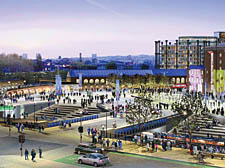|
|
 |
| |
Bold vision for a bright new future
The shuttle from St Pancras to Stratford and the Olympic Games will take a mere seven minutes
If you’d said to someone 10 years
ago there was going to be a 5-star hotel at the front of St Pancras, people wouldn’t have believed it.” Stephen Jordan, the managing director of LCR’s stations and property division, makes his declaration with a smile – and he has good reason to grin. Ten years ago the area was sunk in a morass: crime was rife, buildings lay derelict. Today, with the unveiling of the glistening new St Pancras International, things are definitely looking up; and the future, Mr Jordan promises, is positively rosy.
“We always saw the station as the catalyst for making regeneration happen and it has proved to be true,” he says. “We’ve got a completely new look on the area now. We’re working with people like the British Museum, the British Library and the Wellcome Collection to show King’s Cross is a great place to stay and it’s only going to get better.”
The revamped Barlow train shed and the Eurostar connection – though undoubtedly impressive – are far from the whole story. There are myriad changes afoot in this corner of north London. In 2009, the former glory of the Midland Grand will be reincarnated in a five-star Marriott Hotel and 67 luxury apartments courtesy of Manhattan Lofts, including a £10 million penthouse.
By the time of the Olympics in 2012 the concourse at King’s Cross will be reconstructed; there will be a new swimming pool and farmers’ market, and many of the grand plans for the vast goods yard site – supposedly the largest inner-city regeneration project in western Europe – will have come to fruition.
“King’s Cross has had a bad rap over the years,” Mr Jordan attests. “We’ve cleared out a lot of the nooks and crannies and shed daylight into the area.”
For the last seven years, LCR and their partners, Argent, have been planning the redevelopment of the area, in the sleek form of King’s Cross Central. Now the railway is finished, it can begin.
In the first phase, there are already two big “pre-lets” penned in. University Arts London – an amalgam of Central St Martin’s and Chelsea School of Arts and others – will be pitching camp north of the canal complemented by a new block designed by Stanton Williams. New headquarters for Sainsbury’s are also on the books.
“Already we’ve got quite a bit of critical mass there to start the new development,” says Mr Jordan.
“This area has traditionally been a powerhouse for creativity and design so it’s nice to keep that creative element with the university and preserve the ‘edge’ of the area.
“We agreed right at the beginning this wasn’t going to be a gated area – a sterilised bit of suburbia dropped into central London.”
As with the restoration of the station, the developers have been careful to preserve as much as possible of the historic features of the 67-acre site.
Alongside the old Granary building, which will form part of the new university, the old coal drops (squat structures with large chutes that housed the coal brought by trains) have been converted into an arcade retail area. Offices, houses and schools will stand in lieu of the old goods yards.
The Victorian gasholders, dismantled during the laying of the tracks, will be selectively reassembled. One will become an open public space with an amphitheatre, the other three apartment blocks along the bank of the canal. Each will vary in height to reflect the functional appearance of the old gas cylinders.
Ten billion pounds of investment has been spread over the three LCR sites at Ebbsfleet, Stratford and King’s Cross, and Mr Jordan believes the returns will be far greater: “St Pancras has a role outside of just being a transport hub.
“An important thing for Camden is that the station is a high street as well. It has to have a dual role – serving the passengers and the people around it.”
But he also acknowledges the “quirk” of regeneration: that if you improve an area then you change its character, potentially “pricing out” the local communities.
“It’s a difficult conundrum,” he admits. “If you move an area up for good reasons, how do you make sure you actually still cater for your friends and neighbours? We’ll try and make it as inclusive as possible. We’re not setting out to create an enclave.”
The first phase of King’s Cross Central is scheduled to be ready for use in 2010. Mr Jordan says: “We’ve started already with the realignment of St Pancras Road but we need detailed consent of each phase and each building, even down to the street furniture.
“There’s a whole raft of planning requirements to be met – we’ll try and have much of it completed by the time people walk through here to get to the Olympics, though the whole development itself will probably take about 15 years to complete.”
The arrival of the Olympics in 2012 is expected to accelerate change faster still. With most of the world’s media staying around Bloomsbury and the shuttle from St Pancras to Stratford taking an effortless seven minutes, King’s Cross will be the rightful gateway to the Games.
The future certainly seems bright.
SIMON WROE
> Click here to buy your copy. |
|
 |
|
|
 |
|
 |
|








